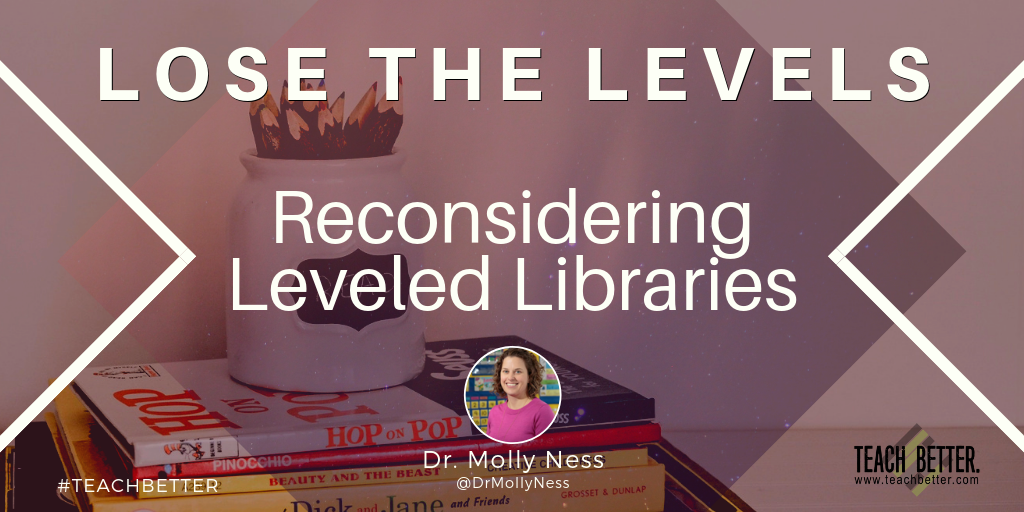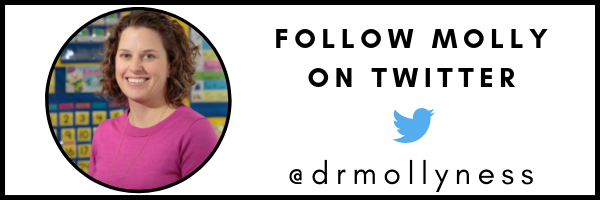In This Post:
- Leveled libraries in classrooms is a good idea taken way too far.
- The level system was created to match readers to texts that best met their reading levels.
- It has become a rigid system that hinders text choice.
- The level system is often applied to inappropriate instructional times.
- The text level-creators themselves – Fountas and Pinnell – recently wrote, “Students’ reading levels have no place in teacher evaluation on report cards to be sent home to parents.”
- Some well-intentioned teachers worry that, without levels, a student might select a text that is too difficult.
Walk into the vast majority of classrooms today – and you’ll find leveled libraries. Books – grouped in bins or baskets – are likely organized by a reading level. Each spine or cover displays a Lexile level or a letter from the Fountas and Pinnell A-Z system.
Confession? This instructional practice makes me cringe. As a reading clinician, I’ve worked with too many children who hang their heads while telling me, “I’m a level G reader, but all of my friends are Level K,” or, “I wanted to read that book, but it’s too high of a level for me.” This overapplication of the leveling system epitomizes a good idea taken way too far.
What Text Levels Were Meant to Do
Created to be a qualitative gradient, the level system initially served to match readers to texts that best met their reading levels. The intent – while a good one – was to direct students to books that they could read with fluency, with appropriate accuracy and meaningful comprehension. But in recent years, these leveling systems have become misconstrued and misapplied, much to the detriment of our readers. What was originally created to be a teacher resource has become a rigid system that hinders text choice and takes away from the joys of reading. The A-Z leveling system was meant to be a teacher tool, not something shared with parents.
I invite you to reorganize classroom libraries to showcase books arranged by genre, topic, format, and author – as opposed to levels. Share on XFurthermore, the leveling system has been applied to inappropriate instructional times. The only time that children should be using leveled text is during guided reading – NOT during independent reading, mini lessons, or for texts to practice at home. The intent is that teachers should use text levels to select guided reading texts, not that children should choose their books from the basket at their level.
The Dangers of the Leveling Craze
Fortunately, many recent voices have warned of the dangers of the inaccurate use of the leveling system. Text level-creators themselves – Fountas and Pinnell – recently wrote, “Students’ reading levels have no place in teacher evaluation on report cards to be sent home to parents.” The American Library Association (ALA) points out that text leveling violates a student’s academic privacy. In a 2017 position statement, the ALA wrote, “When students are required to select books from a visibly leveled collection, their academic information becomes public to everyone in sight.”
[scroll down to keep reading]
A Library Without Levels
What might happen if we eliminated all visible text levels? Some well-intentioned teachers worry that a student might select a text that is too difficult. What’s the worst that could happen here? If a book is too hard, the reader might struggle. Perhaps s/he sticks with it, aiming to fit in with classmates who raved about a popular title. Perhaps they miss key pints and reread the text at a later point. In any case, the reader learns more about his/her self-identity as a reader and begins to shape text choice accordingly. And all of those hypothetical scenarios are better than the alternative. When we tell students, “That book is too hard for you,” we minimize the power of choice and erode their confidence and willingness to attack a challenging text with grit, purpose, and perseverance.
I invite you to reorganize classroom libraries to showcase books arranged by genre, topic, format, and author – as opposed to levels.
One final thought:
If I asked you to write your age or your weight on a sticky note, and display that sticky note on the wall of your faculty lounge, how might you react? Might you be infuriated or embarrassed, or feel appalled by this violation of privacy? Isn’t displaying your students’ text levels equally as invasive?
About Dr. Molly Ness
I am an associate professor in childhood education at Fordham University’s Graduate School of Education. I graduated Phi Beta Kappa from the Johns Hopkins University. After teaching in California with Teach For America, I earned a PhD in Reading Education and a Masters in English Education from the University of Virginia. In 2006, I served as director of the University of Virginia’s McGuffey Reading Clinic. I am a prolific researcher and writer. My current research focuses on reading comprehension, teachers’ instructional decisions and beliefs, and the assessment and diagnosis of struggling readers. I hold over fifteen years of teaching and clinical reading experience. In my current job as a teacher educator and university professor, I teach language, literacy, and research classes to masters and doctoral level students.
Visit Molly’s Website: www.drmollyness.com
Top header image photo by Debby Hudson on Unsplash.


